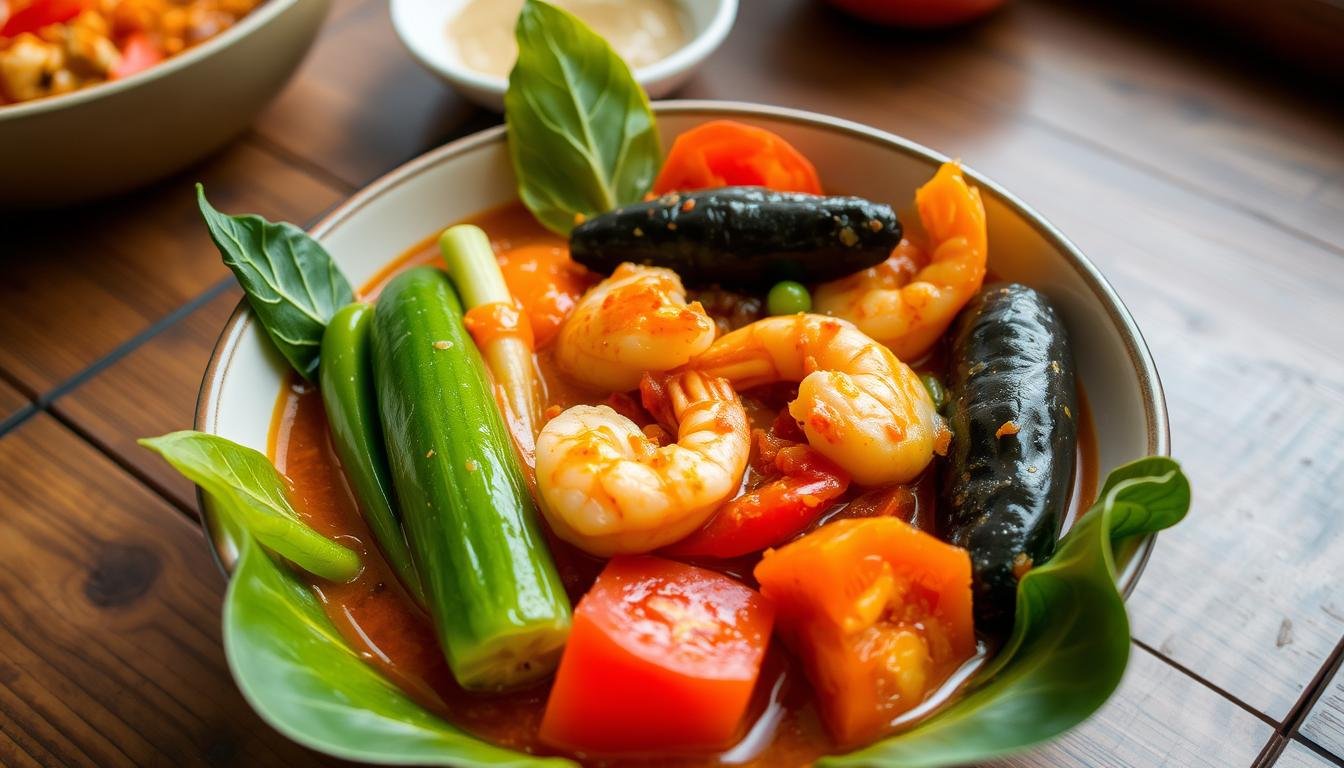Ever wondered why Pinakbet from the Philippines is so loved? This Filipino cuisine favorite comes from Pangasinan. It’s a mix of vegetables like bitter melon, eggplant, and string beans. It’s balanced with shrimp paste and pork belly for a rich taste.
So, what makes this simple vegetable stew so special? Explore Pinakbet and learn its secrets. It’s a true gem of Ilocano dish.
Key Takeaways
- Pinakbet is a beloved Filipino cuisine staple that showcases the diverse culinary traditions of the Pangasinan region.
- The dish features a flavorful blend of locally-sourced vegetables, including bitter melon, eggplant, and string beans, complemented by the umami of shrimp paste and the richness of pork belly.
- Pinakbet is a testament to the regional and local nature of Philippine cuisine, reflecting the unique flavor profiles and ingredients found in the Pangasinan region.
- The dish’s popularity has transcended its regional origins, becoming a beloved vegetable dish enjoyed across the Philippines.
- Mastering the art of Pinakbet allows you to delve into the captivating world of traditional Filipino cuisine and its remarkable diversity.
What is Pinakbet?
Pinakbet, also known as pakbet, is a famous Filipino vegetable dish from Pangasinan, Philippines. The name “pinakbet” comes from the Ilocano word “pinakebbet,” meaning “shrunk” or “shriveled.” This refers to how the vegetables are cooked in the dish.
Definition and Origin of the Term “Pinakbet”
The original Ilocano version of pinakbet uses bagoóng, a fermented fish paste from anchovies. This paste gives the dish its unique taste and smell.
A Historical Perspective on the Dish
Pinakbet comes from Pangasinan’s rich agricultural history. It’s made with local, seasonal produce. This shows the region’s deep connection to the land and its natural gifts.
The Cultural Significance of Pinakbet
Pinakbet is very important in Pangasinan. It shows the province’s farming traditions and the community’s dependence on the land. The dish is linked to the hard work of farmworkers, who cooked it during the farming season.
“Pinakbet is a testament to the ingenuity and resourcefulness of the Pangasinan people, who have crafted this dish to celebrate the bounty of their land.”
Ingredients and Preparation
Pinakbet is a favorite vegetable dish from the Philippines’ Pangasinan region. It’s known for its vibrant flavors and textures. The dish uses fresh, high-quality ingredients. Each one adds to the dish’s perfect balance of tastes and aromas.
Essential Ingredients for Pinakbet
- Bitter melon (ampalaya): Firm, vibrant green in color, with a distinct bitterness that adds depth to the dish.
- Eggplant: Sleek and blemish-free, with a shiny skin that promises a delightful texture when cooked.
- String beans (sitaw): Crisp, with a satisfying snap, these beans bring a delightful crunch to the mix.
- Tomatoes: Ripe and juicy, these plump fruits provide the perfect balance of acidity and sweetness.
- Shrimp paste (bagoong): A key ingredient that adds a savory, umami-rich flavor to the dish.
- Pork belly: The traditional choice, this cut of meat lends a delectable richness and tenderness to the dish.
Tips for Selecting the Freshest Ingredients
Choosing the freshest ingredients is crucial for Pinakbet. The bitter melon should be firm and vibrant green. Eggplants should be free of blemishes and shiny. String beans should snap crisply, and tomatoes should be ripe and juicy.
The shrimp paste and pork belly should be of the best quality. This ensures the perfect balance of flavors and textures in the final dish.
Proper preparation techniques are key to achieving the perfect Pinakbet. Chop the vegetables into even-sized pieces. Sauté the ingredients in the right order. By following these guidelines, you can unlock the true essence of this iconic Pangasinan cuisine and savor the remarkable flavors of Pinakbet.
| Ingredient | Optimal Selection Criteria |
|---|---|
| Bitter melon (ampalaya) | Firm, vibrant green in color |
| Eggplant | Sleek, blemish-free, with a shiny skin |
| String beans (sitaw) | Crisp, with a satisfying snap |
| Tomatoes | Ripe and juicy |
| Shrimp paste (bagoong) | High-quality, with a rich, umami flavor |
| Pork belly | Tender and flavorful |
Variations and Regional Differences
Pinakbet, a classic dish from Pangasinan, has many regional twists. Each area adds its own flavor to this vegetable stew. This shows how Pangasinan cooks adapt Pinakbet to suit their tastes.
Pinakbet Tagalog: Pork Belly, Coconut Milk, and Bold Flavors
In Tagalog Pangasinan, Pinakbet gets a rich flavor boost from pork belly, or lechon kawali. It’s mixed with squash, string beans, eggplant, and bitter melon. This mix creates a perfect balance of flavors and textures.
The dish also includes bagoong alamang (shrimp paste) and coconut milk. These add a creamy and indulgent twist to the dish.
Baked Pinakbet: A Modern Twist on the Classic
In some parts of Pangasinan, Pinakbet has become a baked casserole. It looks like lasagna and uses ground pork. This new method brings fresh flavors and textures to the classic recipe.
Pakbet Ilocano: Crispy Pork Belly and Chicharon
The Ilocano version, Pakbet Ilocano, is a mix of old and new tastes. It’s topped with crispy pork belly, or chicharon. This adds a crunchy texture to the soft stew.
| Pinakbet Variation | Key Ingredients | Unique Characteristics |
|---|---|---|
| Pinakbet Tagalog | Pork belly, squash, string beans, eggplant, bitter melon, bagoong alamang, coconut milk | Rich and creamy texture, bold flavors |
| Baked Pinakbet | Ground pork, layered vegetables | Casserole-like dish, unique baking technique |
| Pakbet Ilocano | Pork belly, chicharon (crispy pork belly) | Crunchy pork belly topping, blending traditional and modern flavors |
These Pinakbet variations show Pangasinan’s culinary creativity. Cooks there keep making this ilocano dish and vegetable stew their own.

Pinakbet and Other Filipino Vegetable Dishes
Pinakbet is a favorite among Filipino vegetable dishes. It’s similar to Sinigang and Laing. Sinigang is a sour soup or stew with many vegetables. It gets its sour taste from tamarind or kamias.
Laing is a spicy dish made with taro leaves and coconut. Even though they taste different, they all show the variety in Filipino cuisine. Pinakbet is special because of its mix of bitter, sweet, and savory flavors.
| Dish | Key Ingredients | Flavor Profile |
|---|---|---|
| Pinakbet | Eggplant, long green beans, bitter melon, okra, squash or sweet potato, bagoong (fermented shrimp paste) | Bitter, sweet, savory |
| Sinigang | Variety of vegetables, tamarind or kamias | Sour |
| Laing | Dried taro leaves, coconut milk, chili, dried fish | Spicy, coconut-based |
These dishes may use similar ingredients or cooking methods. But each one has its own taste. Pinakbet has a bold flavor, Sinigang is sour, and Laing is spicy and creamy. Together, they celebrate the rich flavors of Filipino cuisine.
Pinakbet in Contemporary Cuisine
Pinakbet, the famous vegetable dish from Pangasinan, is now a staple in modern Filipino food. Restaurants worldwide offer Pinakbet, meeting the growing demand from food lovers.
The Popularity of Pinakbet in Modern Filipino Restaurants
Pinakbet’s fame in today’s Filipino restaurants highlights its flexibility. Chefs love to work with it, bringing out its unique flavors and cultural roots. Whether in fancy or casual spots, Pinakbet is a hit, letting people enjoy true Pangasinan tastes.
Innovative Twists and Fusions with Pinakbet
Chefs are now mixing Pinakbet with new ideas, blending it with global tastes. This shows how versatile Pinakbet is, fitting into modern cooking trends while keeping its true essence.
Imagine Pinakbet in pasta or stir-fries. These creative dishes not only please the taste buds but also share Ilocos’ rich food culture with more people.

“Pinakbet has become a canvas for culinary innovation, allowing chefs to showcase their creativity while celebrating the essence of this beloved Pangasinan dish.”
Serving and Enjoying Pinakbet
Pinakbet, the iconic Pangasinan vegetable stew, is a culinary delight. It’s meant to be savored and celebrated. There are traditional accompaniments and serving tips that can make the experience better.
Traditional Accompaniments and Side Dishes
Pinakbet is often served with steamed white rice. This neutral base complements the stew’s bold flavors. Fried pork belly, or lechon kawali, adds a crunchy and savory touch.
Adding bagoong (fermented shrimp paste) brings more umami. It lets diners adjust the taste to their liking.
Tips for Serving Pinakbet for a Memorable Dining Experience
To make the experience memorable, serve Pinakbet family-style. This way, guests can create their own plates. Adding freshly chopped herbs like tomatoes and onions enhances the dish’s look and taste.
By following traditional serving practices and presenting it well, Pinakbet’s rich heritage shines. It showcases the culinary traditions of Pangasinan and the Ilocano people.
| Pinakbet Serving Details | Quantity |
|---|---|
| Servings | 6 |
| Prep Time | 20 minutes |
| Cook Time | 20 minutes |
| Total Time | 40 minutes |
| Calories per Serving | 237 kcal |
Pinakbet is a beloved Pangasinan cuisine and Ilocano dish. It highlights the vibrant flavors of local vegetables. Knowing the traditional accompaniments and serving practices can enhance the pinakbet dining experience. It lets you fully enjoy this iconic pinakbet serving.
Conclusion
Pinakbet, the iconic Pangasinan vegetable stew, is a true gem of the Philippines’ culinary world. This beloved pinakbet dish combines bitter, sweet, and savory flavors. It offers a memorable dining experience.
From its humble beginnings to its current popularity, Pinakbet has won hearts worldwide. It’s a favorite in both local and international circles.
By learning about Pinakbet’s history and how it’s made, you can make it at home. This way, you can share the joy of this Filipino culinary treasure. Whether you like the traditional vegetable stew or the modern twists, Pinakbet is a key part of Pangasinan and Ilocano cuisine.
Exploring pinakbet and its many versions reveals the beauty of Filipino cooking. It’s where tradition meets modern taste. So, let’s enjoy the flavors and celebrate the heritage that Pinakbet represents.
FAQ
What is Pinakbet?
What is the origin of the term “Pinakbet”?
What are the key ingredients in Pinakbet?
Are there regional variations of Pinakbet?
How does Pinakbet compare to other popular Filipino vegetable dishes?
How is Pinakbet served and enjoyed?
Source Links
- Filipino cuisine
- Detailed Guide to Local Cuisine of the Philippines: Traditional Filipino Food & Delicacies | Guide to the Philippines
- Pinakbet
- Pinakbet Tagalog
- Pinakbet Recipe – Foxy Folksy Pinoy Recipes
- Easy Pinakbet Recipe
- What Are Some Variations of Pinakbet in the Tagalog Region? – pinascuisine.com
- Pinakbet Tagalog
- How to Make Pinakbet (Filipino Vegetable Stew)
- The Filipino Vegetable Variety: Pinakbet, Chopsuey, and More — Pinoy Kitchen
- Pinakbet (Filipino Vegetable Stew) | Iankewks
- #FilipinoFoodSessions – Pinakbet: A Family Fave Veggie Packed Dish!
- Pinakbet
- Pinakbet (Pakbet) Filipino Vegetable and Shrimp Stew – Salu Salo Recipes
- No title found
- How To Cook The Best Pinakbet | Eat Like Pinoy
- Pinakbet: How to Make Filipino-Style Pinakbet
- Pinakbet Pure Vegetables Recipe: A Vegan Twist on a Filipino Classic – Anvve Organic and Natural Store at UAE
